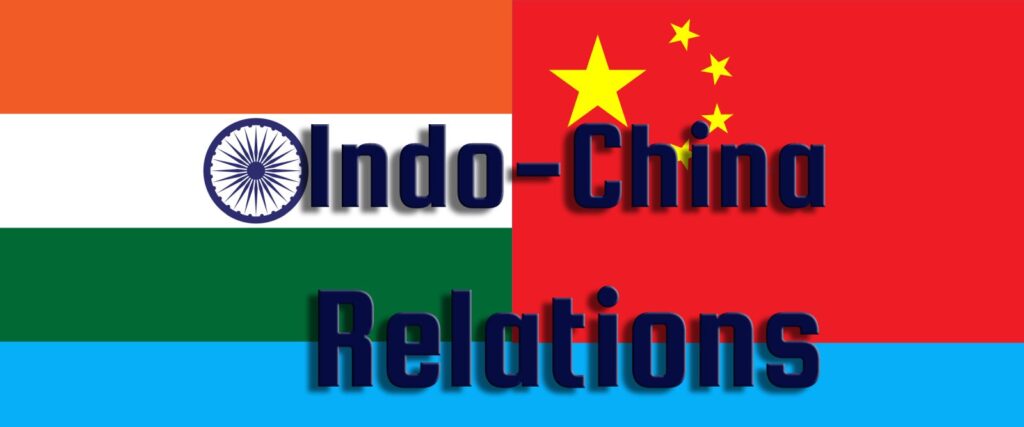Siddhartha Ghosh presently holds the position of Managing Director at Red Lantern Analytica (RLA), an international observer group specializing in monitoring geopolitical developments. With a diverse professional background, Siddhartha has accumulated valuable experience in various roles throughout his career. Armed with a Master’s in Business Administration, he is currently pursuing a Ph.D. His passion for history is evident through his authorship of books, publication of research papers, and his keen interest in historical matters.
During an exclusive conversation with The Interview World, Siddhartha delves into the intricate dynamics of the relationship between India and China. He places a particular focus on border disputes, sheds light on the economic ties binding the two nations, and shares insights into how the Indo-China relationship could impact South Asia and Southeast Asian nations. Additionally, he addresses the global implications arising from the Indo-China relationship and provides recommendations for bolstering diplomatic ties between the two countries. The following are the key highlights from his extensive discussion.
Q: What are the key factors influencing the current geo-strategic dynamics between India and China?
A: The intricate geo-strategic dynamics between India and China are influenced by various factors. Territorial conflicts, particularly along the Line of Actual Control (LAC) in the Himalayan region, have been a significant source of tension. Historical and unresolved territorial disputes contribute to intermittent military confrontations.
Beyond territorial issues, strategic competition is a key aspect. India and China are emerging as dominant forces in their respective Asian regions, extending their impact globally. This strategic rivalry goes beyond border disputes, encompassing efforts to exert geopolitical influence in South Asia, Southeast Asia, and the Indian Ocean region.
The expansion of military forces by both countries has raised concerns among their leadership. The substantial investments made in military capabilities increase the potential for an escalation of tensions and armed conflicts in the region.
Geopolitical partnerships and agreements play a crucial role. India actively fosters strategic partnerships with neighbors like Vietnam and establishes security partnerships with Indonesia. Diplomatic collaborations, such as the Quadrilateral Security Dialogue (QUAD) involving India, Australia, Japan, and the United States, aim to maintain peace and stability in the Indo-Pacific Region. In contrast, China expands its influence through initiatives like the Belt and Road Initiative (BRI) and the ‘String of Pearls’ strategy, attempting to establish networks with neighboring countries in the Indian Ocean Region (IOR). Both nations leverage these partnerships and agreements to garner support.
Technological rivalry is another significant factor. The competition for technological supremacy, particularly in fields like Artificial Intelligence (AI) and 5G, has implications for national security and economic competitiveness. Both India and China make substantial investments in emerging technologies, adding a layer of complexity to their relationship.
Q: How do you assess the ongoing border disputes between India and China, and what implications might they have on the overall relationship?
A: The People’s Republic of China (PRC) consistently engages in saber-rattling, adopting a hostile and aggressive stance. At RLA, we diligently observe and track the PRC’s activities, issuing well-researched statements that emphasize the necessity of countering China’s hegemonic and expansionist motives. The implications of an assertive and aggressive China extend significantly across various dimensions for India.
In terms of border tensions, exemplified in regions like Ladakh, China’s assertiveness escalates territorial disputes, potentially triggering heightened military posturing and the looming risk of conflict. This situation demands India’s increased vigilance and strategic preparedness. On the economic front, an assertive China intensifies competition, introduces trade imbalances, and poses challenges for Indian industries. Consequently, measures must be taken to safeguard domestic interests and fortify economic resilience.
Geopolitically, an aggressive China has the potential to reshape regional power dynamics, affecting India’s strategic alliances and partnerships. This shift may also manifest in increased assertiveness within multilateral forums, necessitating India to adeptly navigate diplomatic challenges. In the technological sphere, competition and potential intellectual property concerns could influence India’s approach to innovation and technology partnerships.
In essence, an assertive China requires India to adopt a multifaceted and adaptive response. This response must encompass diplomatic, economic, and security strategies to safeguard its interests and uphold regional stability.
Q: Despite political tensions, economic ties between India and China have grown. How do you see economic interdependence shaping the geopolitical landscape in the region?
A: The economic ties between India and China hold substantial implications for Asia, influencing regional dynamics, economic expansion, and geopolitical alliances. Key contributors to the economic well-being of both nations are significant bilateral trade and investments, which also have broader repercussions on the Asian region. India and China wield considerable influence in shaping economic integration, supply chain dynamics, and technological advancements within the region.
Collaborative efforts in infrastructure development, such as joint initiatives and shared financial commitments, play a crucial role in enhancing interconnectedness and fostering trade promotion in Asia. However, these economic interdependencies create both opportunities and challenges for other Asian economies. Various economic models present in the region impact economic governance and development initiatives, with a focus on financial collaboration and the maintenance of regional economic stability.
Despite their partnership, the strategic competition between India and China significantly affects the geopolitical landscape of Asia, thereby strengthening their global economic influence and molding international economic trends. The ongoing interaction between these two major economies will continue to be a critical determinant in shaping the economic trajectory of Asia.
Q: How is the Indo-China relationship influencing the broader regional dynamics in South Asia and Southeast Asia?
A: The interplay between India and China holds considerable sway over the strategic alliances and partnerships formed by South Asian nations. Countries like Nepal, Bhutan, Sri Lanka, and Bangladesh meticulously weigh their ties with both India and China, taking into account the broader regional implications.
The security landscape in South Asia is directly impacted by the military posturing and occasional border tensions between India and the People’s Republic of China (PRC). In response to perceived threats or opportunities arising from the Indo-China relationship, neighboring countries may recalibrate their defense and foreign policies.
India and China wield significant influence within regional multilateral organizations like the South Asian Association for Regional Cooperation (SAARC) and the Shanghai Cooperation Organization (SCO). The dynamics and functioning of these forums can be shaped by the relationship between these two key players.
The assertiveness and territorial claims of the PRC in the South China Sea reverberate across Southeast Asian nations. India’s positions on the South China Sea issue and its relationships with Southeast Asian countries can significantly impact regional dynamics.
The Indo-China relationship has far-reaching effects on the security architecture in Southeast Asia. Countries in the region may strive to strike a balance in their relationships with India and China, ensuring the protection of their security interests.
The Association of Southeast Asian Nations (ASEAN) plays a pivotal role in maintaining regional stability. The Indo-China relationship has the potential to influence the unity and cohesion of ASEAN, as member states navigate their ties with these two major powers.
Both India and China actively engage in diplomatic maneuvers to bolster their influence in Southeast Asia. This involves participation in regional forums, bilateral engagements, and efforts to shape the geopolitical narrative in the region. The evolving Indo-China relationship, marked by a blend of cooperation and competition, sends ripples through the broader regional dynamics in both South Asia and Southeast Asia. As these countries navigate their relationships with India and China, the geopolitical landscape continues to evolve, shaped by a multitude of considerations.
Q: What global implications can be anticipated as a result of the evolving relationship between India and China?
A: The dynamic relationship between India and China carries significant implications across diplomatic, economic, and geopolitical spheres. Ongoing border disputes, especially in Ladakh, highlight the crucial need for effective conflict resolution to prevent tensions that might strain their bilateral ties.
In terms of economic collaboration, the synergy between these major Asian powers has the potential to profoundly influence regional and global economies, fostering growth and development. However, the potential challenges of economic competition and trade imbalances demand careful management.
Beyond economics, this evolving relationship shapes the geopolitical landscape in Asia, influencing regional alliances, security dynamics, and power structures. How India and China engage in multilateral forums and address global challenges directly impacts international norms and governance structures. Furthermore, technological competition, particularly in emerging technologies, adds another dimension to their relationship, influencing global tech standards.
Moreover, the People’s Republic of China’s Belt and Road Initiative (BRI) introduces complexities, with India expressing concerns about territorial integrity. The changing dynamics between the two nations also extend to issues of human rights, democracy, and values, impacting their global standing.
Effectively navigating these complexities requires diplomatic finesse, strategic vision, and a commitment to finding common ground. This approach is essential to ensure stability in the region and contribute to global governance.
Q: In your opinion, what diplomatic strategies could both countries employ to mitigate tensions and foster a more stable relationship?
A: To enhance the relationship between India and China and alleviate tensions, diplomatic strategies emphasizing dialogue, cooperation, and mutual understanding are imperative. Several key strategies warrant consideration:
Regular High-Level Dialogues: Facilitating summit meetings and consistent high-level diplomatic dialogues offers a platform for transparent discussions and a better grasp of each other’s concerns.
Diplomatic Hotlines: Establishing and maintaining diplomatic hotlines fosters immediate communication, particularly in crises, preventing misunderstandings and enabling more effective incident management.
Conflict Prevention Mechanisms: Crucial to stability is the development and reinforcement of conflict prevention, crisis management, and de-escalation mechanisms. This involves enhancing existing protocols along disputed borders to avert inadvertent military confrontations.
Track II Diplomacy: Encouraging Track II diplomacy, involving non-governmental entities such as think tanks, academics, and business leaders, provides additional channels for dialogue and the exchange of ideas.
Dispute Resolution Mechanisms: Strengthening or establishing effective mechanisms for territorial dispute resolution contributes significantly to a more stable relationship. This may entail revisiting existing agreements or exploring new diplomatic frameworks.
Confidence-Building Measures: Implementing confidence-building measures, such as information exchanges on military activities and joint military exercises, fosters trust and reduces the risk of miscalculations.
Crisis Communication Protocols: Developing clear protocols for communication during crises, utilizing established channels and crisis management hotlines, is essential to prevent misunderstandings from escalating.
Long-Term Vision: Articulating a shared long-term vision for the relationship provides a roadmap for cooperation, helping overcome challenges. Both countries must express their commitment to this vision.
Sustained and cooperative efforts from both sides are indispensable for achieving a more stable and constructive relationship. It is noteworthy that the effectiveness of these strategies hinges on the evolving geopolitical context and the PRC’s willingness to engage in constructive diplomacy, given its history of diplomatic backtracking.
Q: To what extent do multilateral forums, such as BRICS or the Shanghai Cooperation Organization, impact the Indo-China relationship, and what role could they play in the future?
A: BRICS and the SCO play pivotal roles as key platforms for India and China to actively participate in multilateral diplomacy. These forums not only provide avenues for collaboration on mutual concerns but also facilitate the joint tackling of regional and global issues. Despite these advantages, challenges like geopolitical disparities and limitations within the forums themselves persist, exerting an impact on the broader Indo-China relationship.
In the ever-changing geopolitical landscape, the significance of these multilateral platforms in shaping the interactions between India and China is likely to grow. Success hinges upon adeptly navigating differences and seizing collaborative opportunities within these frameworks. Looking ahead, these forums may increasingly focus on expanding economic cooperation and addressing non-traditional security challenges. As the geopolitical dynamics evolve, the roles of BRICS and the SCO could have a substantial influence on the relationship between India and China. Both nations must skillfully navigate these partnerships, ensuring alignment with their respective national interests.



